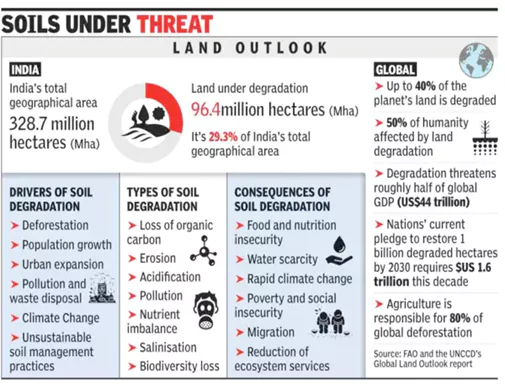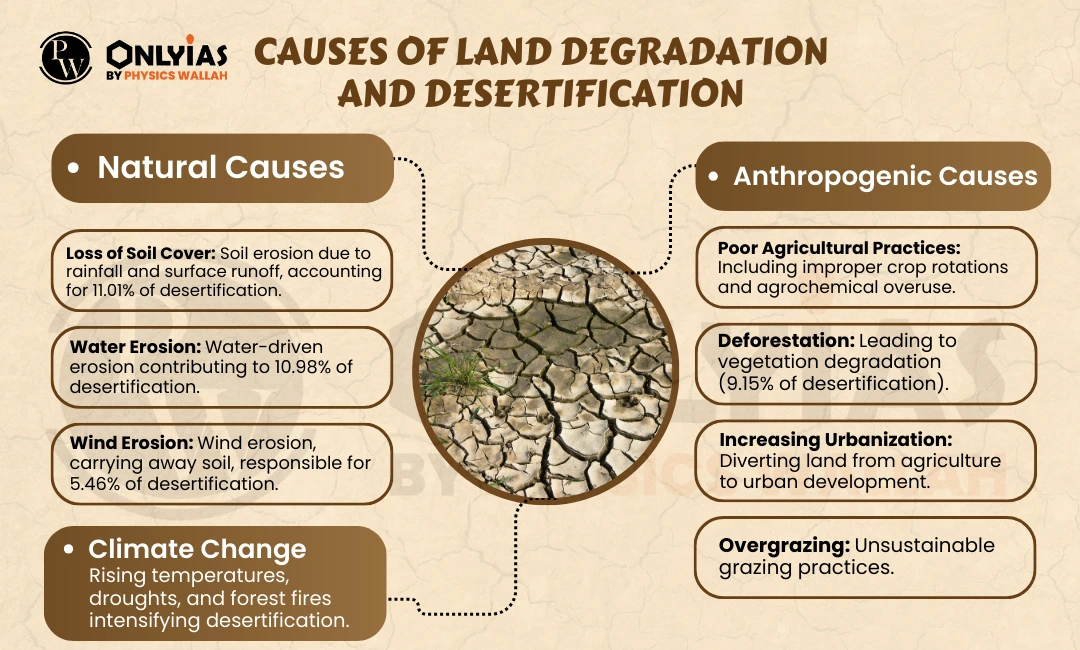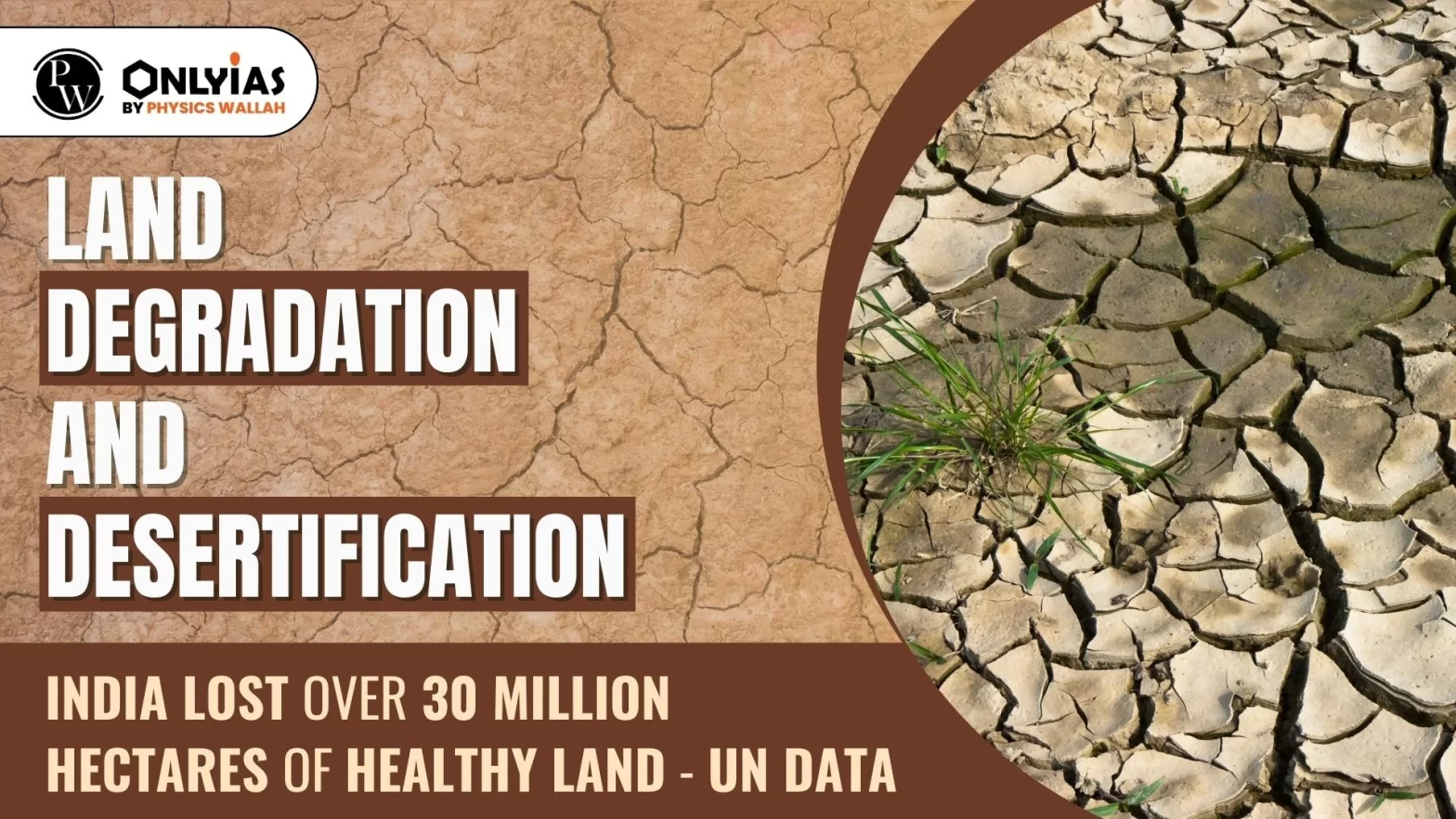Context: :
- This article is based on an Editorial “100 million hectares of arable land lost yearly to degradation, shows UN report” which was published in the DownToEarth. Recently, the UN Convention to Combat Desertification (UNCCD) has launched its first-ever Data Dashboard on land degradation and desertification, aggregating national reporting figures from 126 countries, reveals escalating land degradation worldwide, emphasizing the urgency of global intervention.
What is land degradation?
- Land degradation is the result of human-induced actions which exploit land, causing its utility, biodiversity, soil fertility, and overall health to decline.
- Land degradation within dry land regions (arid, semi-arid and dry sub-humid regions) is termed as ‘desertification’.

What are the causes of land degradation and desertification?
- Natural Causes:
- Loss of Soil Cover: Soil erosion due to rainfall and surface runoff, accounting for 11.01% of desertification.
- Water Erosion: Water-driven erosion contributing to 10.98% of desertification.
- Wind Erosion: Wind erosion, carrying away soil, responsible for 5.46% of desertification.
- Anthropogenic Causes:
- Poor Agricultural Practices: Including improper crop rotations and agrochemical overuse.
- Deforestation: Leading to vegetation degradation (9.15% of desertification).
- Increasing Urbanization: Diverting land from agriculture to urban development.
- Overgrazing: Unsustainable grazing practices.
- Climate Change: Rising temperatures, droughts, and forest fires intensifying desertification.

Impacts of Land Degradation and Desertification
- Economic Impact: Land degradation caused a loss of over 2% of India’s GDP in 2014-15 (TERI).
- Environmental Impact:
- Soil Erosion: Topsoil detachment by water, ice, waves, or wind.
- Loss of Fertility: Due to unscientific farming practices and chemical inputs.
- Salinity/Alkalinity: Caused by over-irrigation or excessive rainfall.
- Water Scarcity: Dryland population vulnerable to water stress and increased drought (178 million projected by 2050).
- Potential Impacts on Human Health:
- Malnutrition: Reduced food and water supplies.
- Water- and Food-Borne Diseases: Poor hygiene and lack of clean water.
- Respiratory Diseases: Atmospheric dust from wind erosion and air pollutants.
- Infectious Diseases: Impacting public health as populations migrate.
- Rights of Indigenous People:
- Insecure land tenure hampers the ability of people and indigenous groups to combat climate change, further endangering their rights and livelihoods.
Government Measures to Combat Land Degradation and Desertification
- Desertification and Land Degradation Atlas: Published by Space Applications Centre (SAC) of the Indian Space Research Organisation.
- Estimated land degradation and desertification in India: 97.84 million hectares in 2018-19.
- Offers state-wise information on degraded land to aid restoration planning.
- Online Portal for Visualization: Developed in collaboration with Space Application Center (SAC), Ahmedabad.
- Allows visualization of degraded land areas and the processes causing degradation.
- Centre of Excellence at ICFRE Dehradun: Envisioned at the Indian Council for Forestry Research and Education (ICFRE), Dehradun.
- Focuses on South-South Cooperation for knowledge sharing and best practices.
Also read: Climate Smart Agriculture (CSA)
Way forward
- Implement comprehensive land use planning to balance stakeholder needs while preserving land resources.
- Promote practices like terrace farming and rainwater harvesting for land restoration, increased crop yields, reduced emissions, and carbon sequestration.
- Align Mahatma Gandhi National Rural Employment Guarantee Scheme (MGNREGS) with Pradhan Mantri Krishi Sinchayee Yojana (PMKSY) to treat 30% more land.
- China’s Great Green Wall: China’s Three-North Shelterbelt Program combats desertification and dust storms with large-scale non-native forest strips in the Gobi Desert region.
Conclusion:
UNCCD’s Data Dashboard reveals a concerning reality for India, with the nation losing more than 30 million hectares of healthy land—highlighting a serious problem of land degradation and desertification that needs urgent attention and action.
| Prelims Question (2016)
What is/are the importance/ importances of the ‘United Convention to Combat Desertification (UNCCD)’?
1. It aims to promote effective action through innovative national programmes and supportive international partnerships
2. It has a special/particular focus on South Asia and North Africa regions, and its Secretariat facilitates the allocation of major portion of financial resources to these regions.
3. It is committed to bottom-up approach, encouraging the participation of local people in combating the desertification.
Select the correct answer using the code given below.
(a) 1 only
(b) 2 and 3 only
(c) 1 and 3 only
(d) 1, 2 and 3
Ans: (c) |



